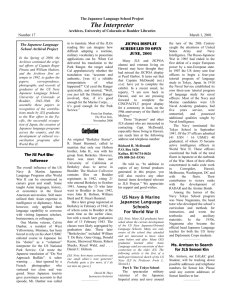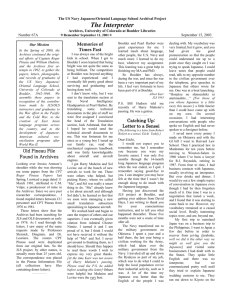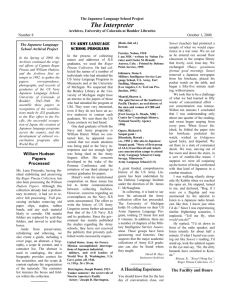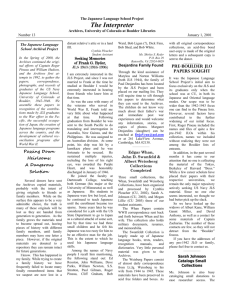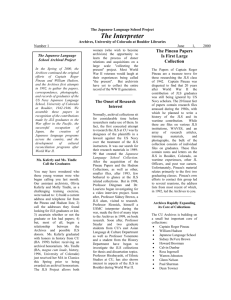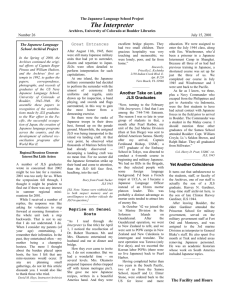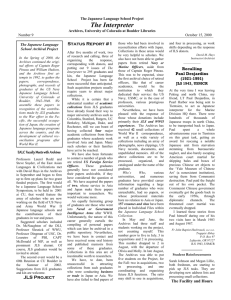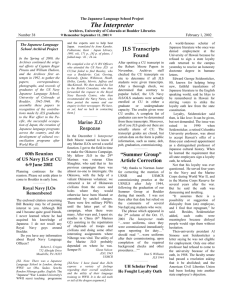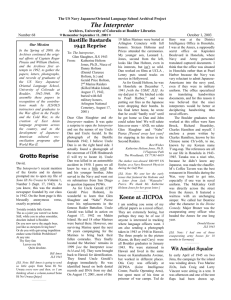The Interpreter - University Libraries
advertisement
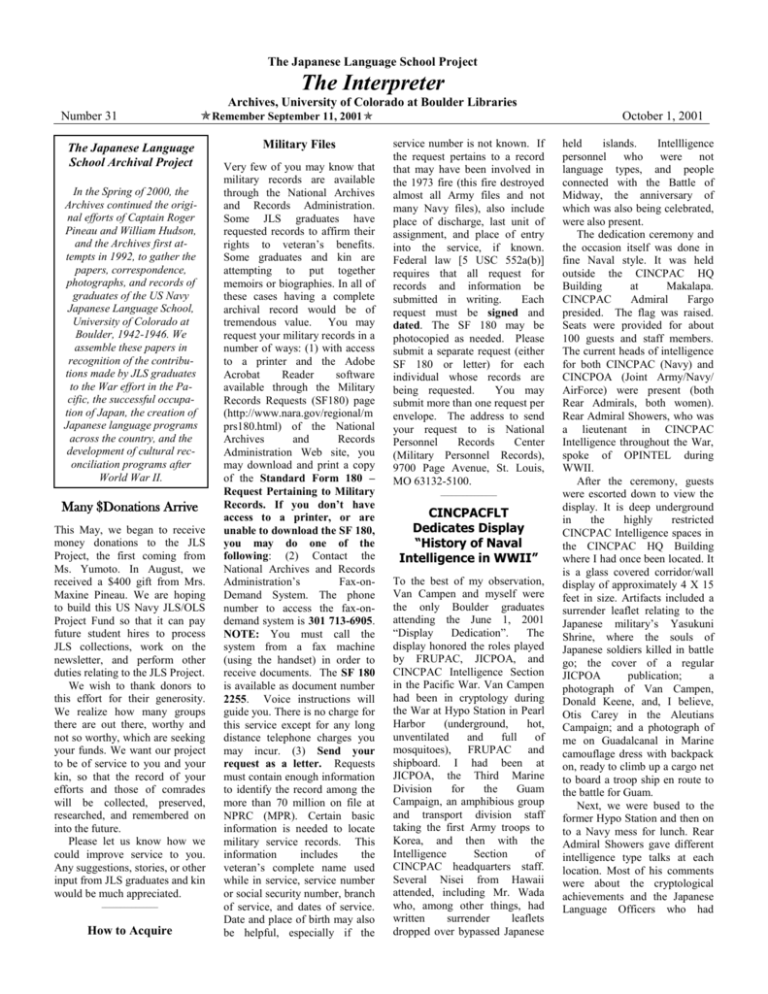
The Japanese Language School Project The Interpreter Number 31 Archives, University of Colorado at Boulder Libraries Remember September 11, 2001 The Japanese Language School Archival Project In the Spring of 2000, the Archives continued the original efforts of Captain Roger Pineau and William Hudson, and the Archives first attempts in 1992, to gather the papers, correspondence, photographs, and records of graduates of the US Navy Japanese Language School, University of Colorado at Boulder, 1942-1946. We assemble these papers in recognition of the contributions made by JLS graduates to the War effort in the Pacific, the successful occupation of Japan, the creation of Japanese language programs across the country, and the development of cultural reconciliation programs after World War II. Many $Donations Arrive This May, we began to receive money donations to the JLS Project, the first coming from Ms. Yumoto. In August, we received a $400 gift from Mrs. Maxine Pineau. We are hoping to build this US Navy JLS/OLS Project Fund so that it can pay future student hires to process JLS collections, work on the newsletter, and perform other duties relating to the JLS Project. We wish to thank donors to this effort for their generosity. We realize how many groups there are out there, worthy and not so worthy, which are seeking your funds. We want our project to be of service to you and your kin, so that the record of your efforts and those of comrades will be collected, preserved, researched, and remembered on into the future. Please let us know how we could improve service to you. Any suggestions, stories, or other input from JLS graduates and kin would be much appreciated. _______________ How to Acquire Military Files Very few of you may know that military records are available through the National Archives and Records Administration. Some JLS graduates have requested records to affirm their rights to veteran’s benefits. Some graduates and kin are attempting to put together memoirs or biographies. In all of these cases having a complete archival record would be of tremendous value. You may request your military records in a number of ways: (1) with access to a printer and the Adobe Acrobat Reader software available through the Military Records Requests (SF180) page (http://www.nara.gov/regional/m prs180.html) of the National Archives and Records Administration Web site, you may download and print a copy of the Standard Form 180 – Request Pertaining to Military Records. If you don’t have access to a printer, or are unable to download the SF 180, you may do one of the following: (2) Contact the National Archives and Records Administration’s Fax-onDemand System. The phone number to access the fax-ondemand system is 301 713-6905. NOTE: You must call the system from a fax machine (using the handset) in order to receive documents. The SF 180 is available as document number 2255. Voice instructions will guide you. There is no charge for this service except for any long distance telephone charges you may incur. (3) Send your request as a letter. Requests must contain enough information to identify the record among the more than 70 million on file at NPRC (MPR). Certain basic information is needed to locate military service records. This information includes the veteran’s complete name used while in service, service number or social security number, branch of service, and dates of service. Date and place of birth may also be helpful, especially if the service number is not known. If the request pertains to a record that may have been involved in the 1973 fire (this fire destroyed almost all Army files and not many Navy files), also include place of discharge, last unit of assignment, and place of entry into the service, if known. Federal law [5 USC 552a(b)] requires that all request for records and information be submitted in writing. Each request must be signed and dated. The SF 180 may be photocopied as needed. Please submit a separate request (either SF 180 or letter) for each individual whose records are being requested. You may submit more than one request per envelope. The address to send your request to is National Personnel Records Center (Military Personnel Records), 9700 Page Avenue, St. Louis, MO 63132-5100. _______________ CINCPACFLT Dedicates Display “History of Naval Intelligence in WWII” To the best of my observation, Van Campen and myself were the only Boulder graduates attending the June 1, 2001 “Display Dedication”. The display honored the roles played by FRUPAC, JICPOA, and CINCPAC Intelligence Section in the Pacific War. Van Campen had been in cryptology during the War at Hypo Station in Pearl Harbor (underground, hot, unventilated and full of mosquitoes), FRUPAC and shipboard. I had been at JICPOA, the Third Marine Division for the Guam Campaign, an amphibious group and transport division staff taking the first Army troops to Korea, and then with the Intelligence Section of CINCPAC headquarters staff. Several Nisei from Hawaii attended, including Mr. Wada who, among other things, had written surrender leaflets dropped over bypassed Japanese October 1, 2001 held islands. Intellligence personnel who were not language types, and people connected with the Battle of Midway, the anniversary of which was also being celebrated, were also present. The dedication ceremony and the occasion itself was done in fine Naval style. It was held outside the CINCPAC HQ Building at Makalapa. CINCPAC Admiral Fargo presided. The flag was raised. Seats were provided for about 100 guests and staff members. The current heads of intelligence for both CINCPAC (Navy) and CINCPOA (Joint Army/Navy/ AirForce) were present (both Rear Admirals, both women). Rear Admiral Showers, who was a lieutenant in CINCPAC Intelligence throughout the War, spoke of OPINTEL during WWII. After the ceremony, guests were escorted down to view the display. It is deep underground in the highly restricted CINCPAC Intelligence spaces in the CINCPAC HQ Building where I had once been located. It is a glass covered corridor/wall display of approximately 4 X 15 feet in size. Artifacts included a surrender leaflet relating to the Japanese military’s Yasukuni Shrine, where the souls of Japanese soldiers killed in battle go; the cover of a regular JICPOA publication; a photograph of Van Campen, Donald Keene, and, I believe, Otis Carey in the Aleutians Campaign; and a photograph of me on Guadalcanal in Marine camouflage dress with backpack on, ready to climb up a cargo net to board a troop ship en route to the battle for Guam. Next, we were bused to the former Hypo Station and then on to a Navy mess for lunch. Rear Admiral Showers gave different intelligence type talks at each location. Most of his comments were about the cryptological achievements and the Japanese Language Officers who had learned their language before the War. A great deal of credit for the whole occasion is due Captain Richard McDonald who organized the very special event, obtained the intelligence artifacts, and researched the exhibit. He also managed to obtain prints of all the heads of Naval Intelligence at CINCPAC from the War to the present. A bit of background about the sole JLS attendees: Van Campen was in the first Boulder class from UC, Berkeley. He chose to live in Hawaii after the War. I was in the Fall Class, 1942, having been incarcerated in a Japanese prison in Shanghai, China. I was sentenced to death by a three Japanese Officer military court on not-entirelytrue charges of spying, obtaining guns for guerrillas and helping a US Marine POW to escape. I was traded for a Japanese from the US and returned with the first US/Japanese exchange of civilians on the Swedish ship, the Gripsholm. I had the dubious honor of being the “last man” at JICPOA, having to dispose of all the classified and other records. (Two copies were sent to the archives in Washington, DC, and the rest was taken in many truck loads, under guard, to the Hawaiian Power Company and thrown in their furnace.) Having been transferred to CINCPAC HQ Intelligence Staff soon after the War’s end, I am probably the only JICPOA/JLO who never got to Japan for the Occupation. I was in Japan in 1940 and 1998. I remained in the Navy for 33 years. CPT Wendel Furnas USN, ret., JLS 1943 [Ed. Note: Given Layton’s book, it was fitting for ADM Showers to have the last word.] New Collections The following are further collections promised or recently received by the Archives: Holtom Family Orville Lefko Miya [Joe] Sano Sanford L. Schultheis J. Owen Zurhellen, Jr. $Donations Received The Archives has recently received generous donations from: Maxine Pineau

